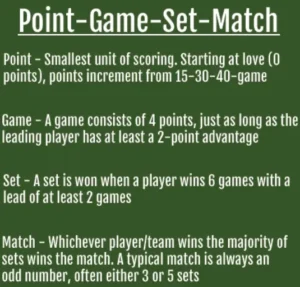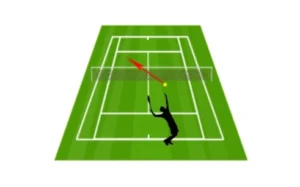It’s crucial to comprehend the official tennis scoring system and the many phrases that are used, whether you’re just a tennis spectator looking to figure out who’s winning or you’re just getting started playing matches of your own. If you don’t know this information, you may find yourself a little perplexed whenever someone in your vicinity discusses tennis scores. We will therefore discuss the various elements of the tennis scoring system today, along with an example of how to score a match.
Scoring : Tennis Point Distribution
The scoring schemes employed in other traditional sports and tennis are very dissimilar. Tennis had to go above and beyond by utilizing a ton of jargon, whereas most other sports just use a plain ol’ “point” for scoring. Not only that, but the tennis scoring system only recognizes one winner and one loser for each match; ties of any kind are not permitted. Now, let’s review the various terminology used in the tennis scoring system.
Terms
Points: Also known as a score
In tennis, a point is the smallest scoring unit. A player needs to lead by at least two points and win a total of four points to win a “game.” However, tennis players do not utilize the logically simple 0-1-2-3-4 point system. Of course not. The system used by tennis players to express a player’s point total is as follows:
- 0 Points — Love
- 1 Point — 15
- 2 Points — 30
- 3 Points — 40
- 4 Points — Game (2 point lead required)
A little unclear? You’ll quickly become proficient with the tennis scoring regulations, so don’t worry. In addition to this, you’ll also need to be familiar with the following terms:
- All — Used to characterize even scores; 40-40 is an exception. 0-0 would represent a love-all, 15-15 would represent a 15-all, and 30-30 would represent a 30-all.
- Deuce: A 40-40 score is referred to as such. A player needs to win two straight points in order to win the game if a deuce is achieved. The score goes back to deuce if a player wins one point and then loses the next.
- Advantage: When a deuce is reached, the player who wins the first point is considered to have “advantage.”
- Advantage In: The server may declare the score as “advantage in” if it is the player with the advantage.
- Advantage Out: The server may declare the score to be “advantage out” if the recipient is the player with the advantage.
There isn’t exactly a clear explanation for why the tennis scoring system is set up this way. Right now, the best estimate available suggests that it originated in medieval France.
According to one idea, the tennis scoring system was inspired by a clock’s face. With the exception of the last point, each point would progress the player by 15 toward the objective of reaching 60. This would permit the deuce rule, which would require a player to win two points (40 => 50 => 60) in order to achieve 60 if they reached a deuce.
According to a different hypothesis, the origins of the tennis scoring system can be traced back to the French game “Jeu de Paume,” in which the server was allowed to advance 15 feet upon scoring a point, an additional 15 feet upon scoring another, and finally 10 feet closer if the server scored a third time.
One theory concerning the origin of the word “love” is that it originated from the French phrase “l’oeuf,” which means “the egg,” because an egg is similar to the number zero.
Sets
The first player or team to win six games wins a set. Every game, players switch off between serving and returning, and the majority of matches follow one of two predetermined formats:
- Advantage Set: In order to have a 2-game advantage over their opponent(s), a person or team must win at least 6 games. Until a player or team wins the set by at least two games, the set goes on.
- Tie-Break Set: Designed to expedite matches, James Van Alen introduced the tie-break in 1965. A minimum of six games must be won by the player or team, with a two-game lead over the opposition(s). A tie-break game is used to decide the winner if the score is 6-6. In order to win the tie-break game and set, a player needs to score a predetermined number of points (usually 7, 8, or 10 points) with a minimum 2-point advantage.
Matches
A player or team must win the majority of sets in order to win the match, which is usually made up of an odd number of sets. The finest matches usually consist of three or five sets.

Tennis Serve Start, Tennis Scoring Method, and How to Score a Game of Tennis
After discussing the tennis scoring system and the many terminology related to it, let’s look at an example of how to score a tennis match from the beginning to the end of a singles match.
In order to decide who serves first in a match, the game starts with a toss. The player who called it correctly gets to pick who serves or which end of the court they want to play on. It’s as easy as flipping a coin or spinning the racket. The choice remaining is chosen by the toss loser.
In the event that player 1 wins the toss and decides to serve first, they will do so for the duration of the first game, or until someone else wins. After that, Player 2 decides which side of the court to start on. Play continues if Player 1’s serve, which originates from the right side of the court, lands inside the opponent’s service box.
Assume that player 1 scores the opening point. Now, the score is “15-love,” and the server (unless it’s a tournament where players are pampered) must reveal the score at the beginning of each point.

To serve, Player 1 will now move to the left side of the court, or the advantage court. For each new point, Player 1 will switch sides of the court.
This point is won by Player 2, making the score “15-all.”
The next point is won by Player 1, making the score “30-15.”
Since the leading player is ahead by two points and only needs one more to win the game, the score would be “40-15,” or a double game point. Player 1 wins
the subsequent point. A “40-love” score would be treble game points, whereas a “40-30” score would be a game point. The terms “break point,” “double break point,” and “triple break point” would be used if the scores were inverted.
Player 1 wins the game if they take the following point.
While player 2 wins two straight while the score is “40-15,” the score changes to “40-40,” or “deuce,” which necessitates more play. Recall that a player must lead by at least two points and reach four points to win the game.
Assume that circumstance B materializes and that the score is now “deuce.” After Player 1 earns a point, the server is now in the lead. The next point is won by Player 2, bringing the score back to a deuce. Player 2 then scores another point, giving the server a current “advantage out” score. After this, Player 2 wins a third point and the match.
It hasn’t ended yet. Yes, it may seem overwhelming at first, but understanding all of this is essential if you want to know how to keep score in tennis. Player 2 will now have the opportunity to serve for the duration of the second game. The server reports the score of each game in the beginning, beginning with their own. The score in this scenario would be “1-0.” Assume that player 2 also prevails in this match. Now it’s player 1’s chance to serve once more.
Players trade court sides to serve in each odd-numbered game. In other words, player 1 will now play where player 2 was just playing, and vice versa. After Player 1 declares “0-2,” the third game starts.
The set is won by the player who wins six games with a minimum two-game advantage. The following are the possible scores to win a set: “6-0”, “6-1”, “6-2”, “6-3”, or “6-4”. The player in the lead needs to win one more game to win the set if the score is “6-5.” Play will proceed to either an advantage set or a tie-break game if the score reaches “6-6.” Do you still recall the phrases from the tennis scoring system? If not, allow us to jog your memory:
- A player does not win an advantage set until they have a two-game lead. Scores for an advantage set can be “9-7,” “8-6,” “8-10,” etc. as examples.
- The first player to reach 7 points (best of 12) with at least a 2-point advantage wins the set in a tie-break scenario. In a tie-break game, there are additional rules pertaining to serving.
One set ends, and then another one starts, with the player who received the previous set now serving. This keeps on until a player wins most of the sets, usually two or three out of five.
Following all of this, the player or team who wins the majority of sets in that match advances normally through the tournament. And that’s how a professional tennis player scores a match, ladies and gentlemen.
